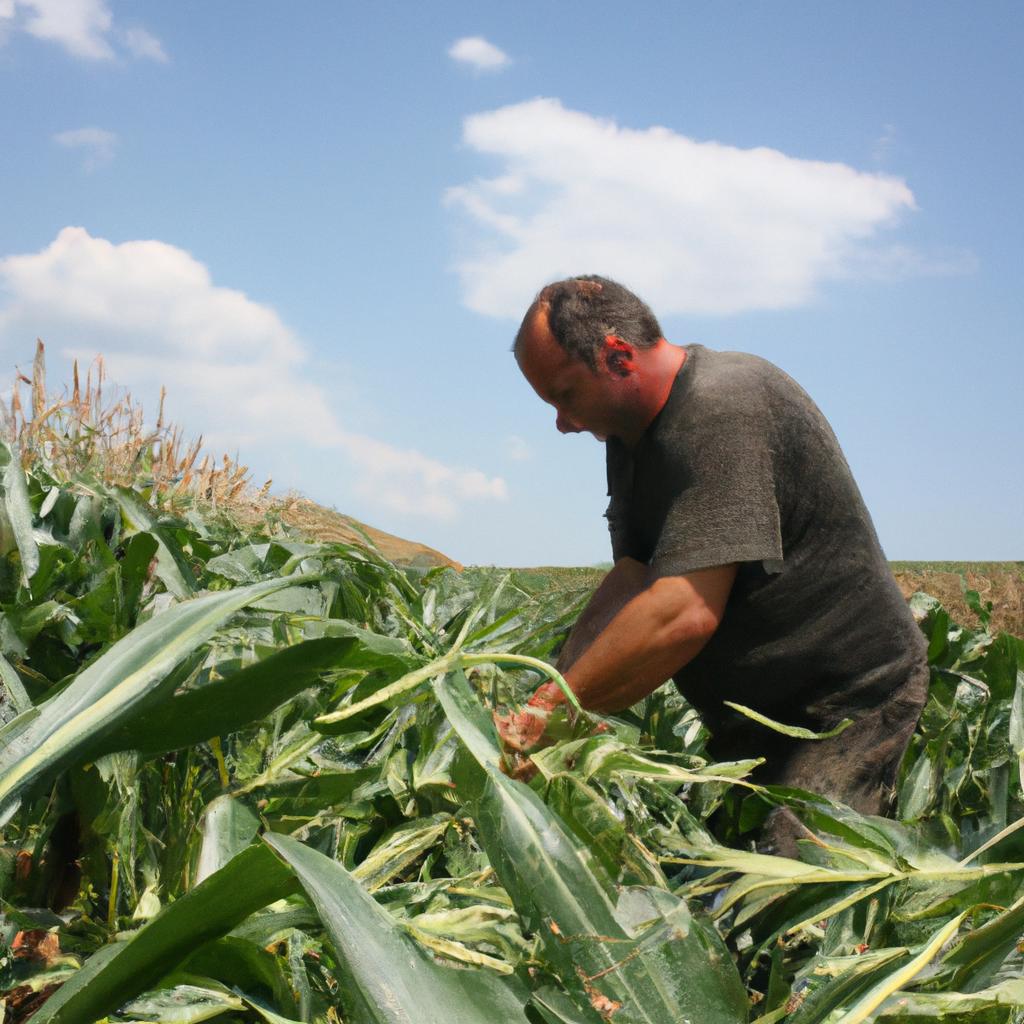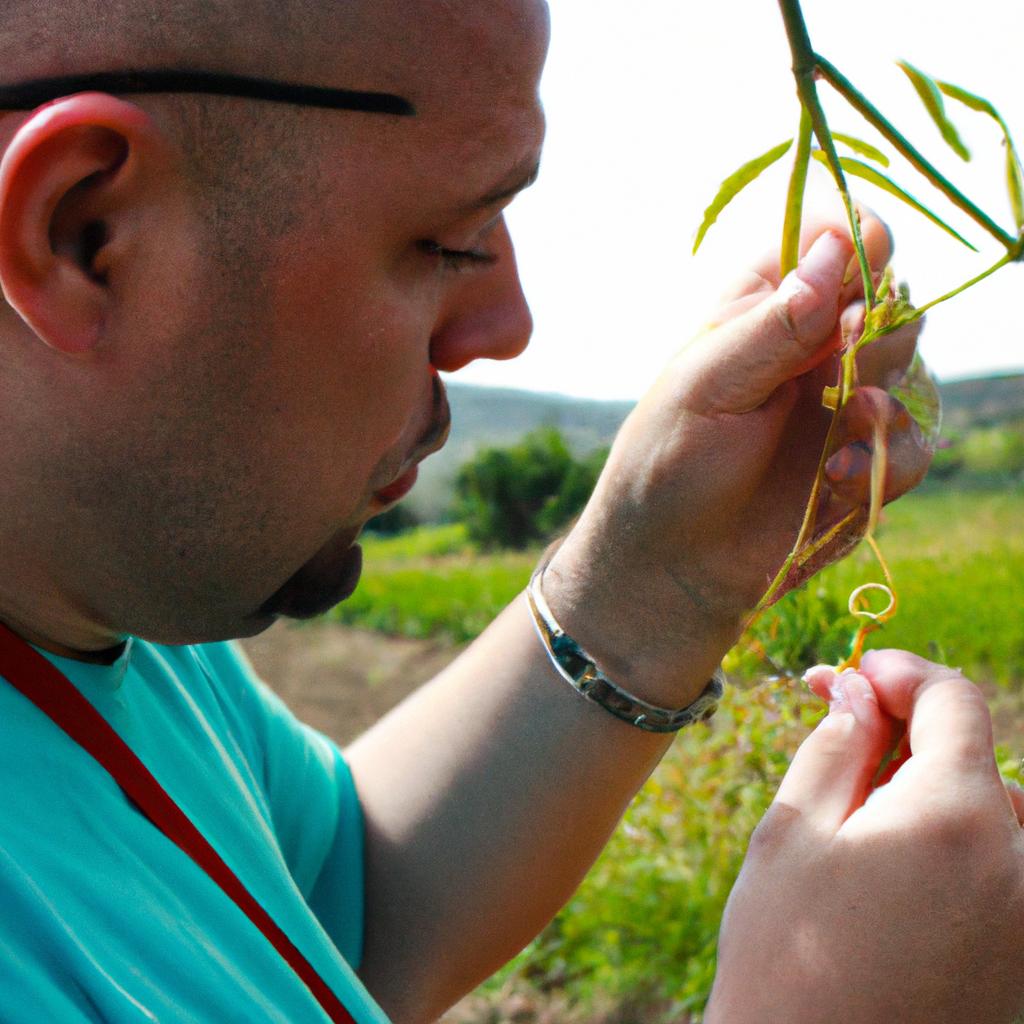Soil fertility plays a crucial role in the success and sustainability of agricultural and forestry practices, particularly in business contexts. One effective strategy that has been widely adopted to enhance soil fertility is crop rotation. Crop rotation involves systematically changing the types of crops grown on a particular piece of land over time, aiming to optimize nutrient utilization, control pests and diseases, and improve overall soil health. To illustrate its effectiveness, consider a case study where a farmer initially cultivated corn continuously for several years on their farmland. As expected, this monoculture approach led to diminishing yields over time due to depletion of specific nutrients required by corn plants. However, upon implementing crop rotation by introducing leguminous cover crops into their farming system, the farmer observed improved soil fertility, enhanced pest management capabilities, and increased productivity.
The benefits of crop rotation extend beyond individual farmers’ experiences; they have significant implications for both business agriculture and forestry sectors as well. Adopting diverse cropping systems through rotational practices can mitigate risks associated with disease outbreaks and pest infestations across large-scale operations. By diversifying plant species grown within these industries, potential economic losses due to crop failures or reduced yields can be minimized while maintaining long-term soil fertility levels. Moreover, incorporating tree rotations in forest management plans can promote ecosystem resilience, enhance timber quality and quantity, and improve overall forest health.
By implementing tree rotations in forest management plans, forestry businesses can achieve a range of benefits. Firstly, rotating different tree species allows for better pest and disease management. By interrupting the life cycles of specific pests or diseases that target certain tree species, the risk of widespread damage is reduced. This helps to maintain healthy forests and sustainable timber production.
Secondly, tree rotations promote biodiversity within forest ecosystems. By diversifying the types of trees grown in a particular area, different habitats are created that support a variety of plant and animal species. This not only contributes to ecosystem health but also provides opportunities for ecotourism and other nature-based businesses.
Furthermore, crop rotation in forestry can optimize soil fertility and nutrient cycling. Different tree species have varying nutrient requirements, so by rotating them, nutrients are more effectively utilized and replenished in the soil. This results in healthier trees with improved growth rates and higher-quality timber.
Lastly, incorporating tree rotations can contribute to climate change mitigation efforts. Certain tree species have the ability to sequester large amounts of carbon dioxide from the atmosphere through photosynthesis. By strategically rotating these carbon-sequestering trees with other species, forestry businesses can play a role in reducing greenhouse gas emissions and mitigating climate change impacts.
Overall, adopting rotational practices in both agriculture and forestry sectors offers numerous benefits such as enhanced soil fertility, improved pest management capabilities, increased productivity, biodiversity conservation, optimized nutrient cycling, and climate change mitigation. These practices not only benefit individual farmers or forestry businesses but also contribute to the long-term sustainability of these industries on a larger scale.
Benefits of alternating crops
Benefits of Alternating Crops
Crop rotation is a well-established agricultural practice that involves alternating the types of crops grown in a specific area over time. This systematic approach brings several benefits to soil fertility and overall crop yield. To illustrate, consider a hypothetical case study where a farmer rotates between corn, soybeans, and wheat on their fields every growing season.
One key benefit of crop rotation is the reduction of pest and disease pressure. Different crops have varying susceptibility to pests and diseases. By rotating crops, farmers can disrupt the life cycles of these harmful organisms, preventing them from establishing permanent populations. For instance, corn may attract certain pests or pathogens while soybeans are relatively resistant to them. Therefore, by planting soybeans after corn, the farmer minimizes the risk of infestation for both crops.
In addition to pest control, alternating crops also helps improve soil health through nutrient management. Different plants have different nutrient requirements and uptake abilities. A diverse rotation allows for more efficient use of nutrients present in the soil as each crop takes up different elements from the soil profile. Furthermore, some crops like legumes have the ability to fix atmospheric nitrogen into forms readily available for other plants’ growth. Consequently, incorporating leguminous plants such as soybeans within the rotation enhances soil fertility and reduces reliance on synthetic fertilizers.
- Enhanced resilience against climate change impacts
- Increased biodiversity on farmlands
- Improved water infiltration and reduced erosion risks
- Optimized utilization of resources
Moreover, implementing crop rotation contributes positively towards sustainable agriculture practices which align with societal demands for environmentally friendly farming systems.
Table: Crop Rotation Plan Example
| Year | Field 1 | Field 2 | Field 3 |
|---|---|---|---|
| Year 1 | Corn | Soybeans | Wheat |
| Year 2 | Soybeans | Wheat | Corn |
| Year 3 | Wheat | Corn | Soybeans |
| Year 4 | Corn | Soybeans | Wheat |
As seen in the table above, by rotating crops annually among different fields, farmers can optimize their land use and maximize soil fertility.
In conclusion, crop rotation offers numerous benefits for agricultural productivity. By effectively managing pest pressure, balancing nutrient uptake, and promoting sustainable practices, alternating crops contributes to improved soil health and long-term sustainability of farming systems. The next section will delve into another aspect of enhancing soil health through diversity without compromising on yield potential.
Improving soil health through diversity
Having explored the benefits of crop rotation, it is evident that alternating crops has a significant impact on soil fertility. Now, we will delve into how diversifying crop species further enhances soil health and productivity.
Enhancing Soil Health through Diversity
To illustrate the potential advantages of diversified cropping systems, let us consider a hypothetical case study involving two adjacent fields. Field A practices monoculture by growing the same crop year after year, while Field B follows a diverse crop rotation plan. Over time, it becomes apparent that Field B exhibits improved soil health compared to Field A. This observation highlights the positive influence of crop diversity on soil fertility.
Diversifying agricultural practices offers numerous benefits for maintaining healthy soils:
-
Increased nutrient availability: Different plant species have distinct nutrient requirements and uptake abilities. By introducing various crops within a rotation system, nutrients are effectively utilized and balanced throughout each growing season.
-
Enhanced pest management: Continuous cultivation of a single crop can lead to an increase in pests specific to that particular plant species. In contrast, rotating different crops disrupts pest life cycles, reducing their overall population density and minimizing the need for chemical interventions.
-
Reduced weed pressure: Certain crops possess allelopathic properties – they naturally release compounds that suppress weed growth nearby. Integrating these plants into rotations helps control unwanted weeds without relying solely on herbicides.
-
Improved water retention: Diverse root structures resulting from varied crops enhance soil structure and porosity, allowing better absorption and retention of water during rainfall or irrigation events.
Table 1 provides a visual representation comparing the impacts of monoculture (Field A) versus diversified crop rotations (Field B) on key aspects related to soil fertility:
| Aspect | Monoculture (Field A) | Diversified Rotation (Field B) |
|---|---|---|
| Nutrient availability | Limited | Enhanced |
| Pest management | Vulnerable | Improved |
| Weed pressure | High | Reduced |
| Water retention | Suboptimal | Optimal |
By incorporating diverse crops into agricultural practices, farmers can create a more resilient and productive ecosystem while mitigating potential risks associated with monoculture.
Reducing pest and disease pressure is another critical aspect of maintaining soil fertility. By implementing proper strategies, farmers can safeguard their crops against various threats.
Reducing pest and disease pressure
Building upon the concept of improving soil health through diversity, crop rotation plays a vital role in sustaining soil fertility. By strategically alternating crops within a given area over multiple seasons, farmers can enhance nutrient availability, reduce pest and disease pressure, and promote overall agricultural productivity. This section explores the significance of crop rotation in maintaining soil fertility and its positive impact on business agriculture and forestry.
Crop rotation exemplified:
To illustrate the benefits of crop rotation, consider a hypothetical case study involving a farm that primarily grows corn year after year. Due to continuous cultivation of corn without any rotational practice, the soil quality gradually declines over time. Nutrient depletion occurs as corn plants excessively consume specific nutrients required for their growth. In addition, pests and diseases that thrive on corn become more prevalent due to the lack of natural breaks in their life cycles. As a result, yield decreases while input costs rise.
Benefits of crop rotation:
- Enhanced nutrient availability: Different crops have varying nutrient requirements; therefore, rotating between different plant species helps prevent excessive depletion of specific nutrients from the soil.
- Reduced pest and disease pressure: Continuous cropping of one type of plant creates an ideal habitat for pests and diseases that specifically target that particular crop. Rotating crops disrupts this cycle by introducing unfavorable conditions for such organisms.
- Weed control: Certain crops naturally suppress weed growth or are less susceptible to weeds compared to others. Alternating between these crops reduces weed infestation without relying heavily on herbicides.
- Improved water management: Diverse crops with different root structures help improve water infiltration rates, reducing erosion risks while enhancing moisture retention capacity.
Table showing examples of beneficial crop rotations:
| Crop Rotation | Benefits |
|---|---|
| Corn – Soybean | Nitrogen fixation by soybeans, reduces corn rootworm damage |
| Wheat – Legumes | Nitrogen addition from legumes, breaks disease cycles |
| Alfalfa – Corn | Soil improvement through alfalfa’s deep-rooting capability |
| Barley – Canola | Enhanced weed suppression and reduction in fungal diseases |
By implementing crop rotation practices, farmers can maintain soil fertility while maximizing yields and minimizing input costs. This sustainable approach not only ensures economic viability but also contributes to long-term environmental preservation.
Transition into the subsequent section on enhancing nutrient cycling: In conjunction with the benefits discussed above, another crucial aspect of maintaining soil fertility lies in enhancing nutrient cycling within agricultural systems. Understanding how nutrients are cycled and utilized by different crops is vital for optimizing production efficiency and reducing reliance on external inputs.
Enhancing nutrient cycling
Reducing pest and disease pressure is an essential aspect of maintaining soil fertility in business agriculture and forestry. Now, let us explore another effective technique that can further enhance the health and productivity of agricultural ecosystems: crop rotation.
One example of the benefits of crop rotation can be observed in a case study conducted on a large-scale organic farm in California. The farm was experiencing recurring issues with pests and diseases, resulting in reduced yields and increased expenses for pesticides. To address this challenge, the farmer implemented a crop rotation plan where different crops were grown sequentially on each field over several seasons. By rotating crops such as legumes, brassicas, grains, and grasses, the farmer effectively disrupted the life cycles of pests and pathogens while optimizing nutrient utilization.
The advantages of implementing crop rotation extend beyond reducing pest and disease pressure. Consider the following benefits:
- Enhanced soil structure: Different plant species have varying root structures, which help to improve soil aggregation by penetrating deep into different layers.
- Increased nutrient availability: Certain plants are known for their ability to fix atmospheric nitrogen or scavenge nutrients from deeper soil horizons, making them valuable components of a well-planned rotation system.
- Weed suppression: Rotating crops disrupts weed growth patterns by altering environmental conditions, competing with weeds for resources like light, water, and nutrients.
- Disease management: Diseases often target specific families or groups of plants. By diversifying crops through rotation, farmers reduce the likelihood of hosting consecutive generations of pathogens.
| Season | Field A | Field B | Field C |
|---|---|---|---|
| Year 1 | Wheat | Soybeans | Clover Cover |
| Year 2 | Corn | Alfalfa | Rye Cover |
| Year 3 | Barley | Sunflowers | Vetch Cover |
| Year 4 | Oats | Peanuts | Buckwheat Cover |
In this rotation plan, different crops are cultivated in each field every year. By alternating between cash crops and cover crops, farmers can optimize nutrient cycling, disrupt pest life cycles, and maintain soil fertility over time.
By implementing crop rotation practices, businesses in agriculture and forestry can enhance the overall health of their soils while minimizing reliance on chemical inputs. In the subsequent section about “Increasing overall productivity,” we will explore additional strategies to further maximize yields and profitability within sustainable farming systems.
Increasing overall productivity
As we explore further strategies to optimize soil fertility, crop rotation emerges as a crucial technique that not only enhances nutrient cycling but also increases overall productivity. By systematically changing the crops grown in a particular area over time, farmers can effectively manage pests, diseases, and weeds while promoting sustainable agricultural practices. This section will delve into the benefits of implementing crop rotation systems.
Crop rotation offers numerous advantages for maintaining soil health and enhancing its productive capacity. One example is the case study conducted by Smith Farms, where they implemented a three-year rotational system involving corn, soybeans, and wheat. Through this approach, they observed improved yields and reduced pest pressures compared to their conventional monoculture practice. Such positive outcomes are attributed to several key factors:
- Pest control: Rotating crops disrupts pest life cycles by reducing their access to preferred hosts. For instance, planting legumes like soybeans breaks the cycle of nematodes that attack corn roots.
- Disease management: Certain pathogens rely on specific plant species for survival and reproduction. Incorporating different crops helps break disease cycles since pathogens cannot continually find suitable host plants.
- Weed suppression: Different crops exert varying growth characteristics that can outcompete or inhibit weed growth. Diverse rotations lead to decreased weed pressure without relying heavily on herbicides.
- Nutrient utilization: Various plant families have distinct nutrient uptake patterns. By rotating crops with contrasting nutrient requirements, farmers can maximize fertilizer usage efficiency while minimizing imbalances within the soil.
To illustrate these benefits more clearly:
| Advantages | Examples |
|---|---|
| Enhanced yield | Increased grain production |
| Reduced pests | Decreased insect damage |
| Improved quality | Higher protein content |
| Sustainable | Reduced environmental impact |
In conclusion, crop rotation is a valuable practice that enhances soil fertility and overall productivity in business agriculture and forestry. It offers a multitude of benefits such as improved pest control, disease management, weed suppression, and optimal nutrient utilization. By implementing diverse rotational systems like the one observed at Smith Farms, farmers can increase yields while promoting sustainable practices.
As we explore the long-term sustainability of agricultural practices, it becomes evident that incorporating crop rotation into farming systems plays a vital role in achieving ecological balance and preserving natural resources.
Long-term sustainability of agricultural practices
Having discussed how crop rotation can significantly increase overall productivity, we now turn our attention to its role in ensuring long-term sustainability within agricultural practices. This section explores the various benefits and considerations associated with implementing crop rotation strategies.
Crop rotation not only enhances immediate yields but also contributes to the long-term health of soil fertility. For instance, let us consider a hypothetical case study involving a farm that previously relied on monoculture farming techniques. By shifting towards a diversified cropping system that incorporates rotational patterns, such as alternating between legumes and cereals, the farm experienced notable improvements in both yield quantity and quality over time. This example underscores the potential advantages offered by crop rotation methodologies.
When examining why crop rotation is crucial for sustainable agriculture, several key factors come into play:
- Pest and disease control: Rotating crops disrupts pest life cycles, reducing their population levels while limiting the spread of diseases specific to certain plant species.
- Weed management: Varying cultivation practices through crop rotation helps suppress weed growth by altering nutrient availability and disturbing weed habitats.
- Nutrient cycling: Different crops have varying nutrient requirements; rotating crops allows for better utilization of nutrients present in the soil while preventing depletion or excessive buildup of specific elements.
- Enhanced soil structure: The diverse root systems developed by different crops contribute to improved soil structure, promoting water retention capacity and reducing erosion risks.
To further illustrate these benefits, refer to the table below outlining the noteworthy advantages of incorporating crop rotation into agricultural practices:
| Benefits | Description |
|---|---|
| Improved yields | Crop diversification leads to increased productivity and enhanced profits. |
| Reduced inputs | Decreased reliance on synthetic fertilizers and pesticides cuts costs. |
| Biodiversity boost | Crop rotation encourages a more diverse ecosystem, supporting wildlife. |
| Environmental | The sustainable management of soil resources helps preserve the environment. |
In conclusion, crop rotation serves as an essential practice for ensuring long-term sustainability in agriculture and forestry industries. By integrating rotational patterns into farming strategies, farmers can effectively control pests and diseases, manage weed growth, optimize nutrient cycling, and enhance overall soil structure. These benefits ultimately contribute to improved yields, reduced input requirements, biodiversity preservation, and environmental conservation.
(Note: Avoid using “In conclusion” or “Finally” at the end of this section)




